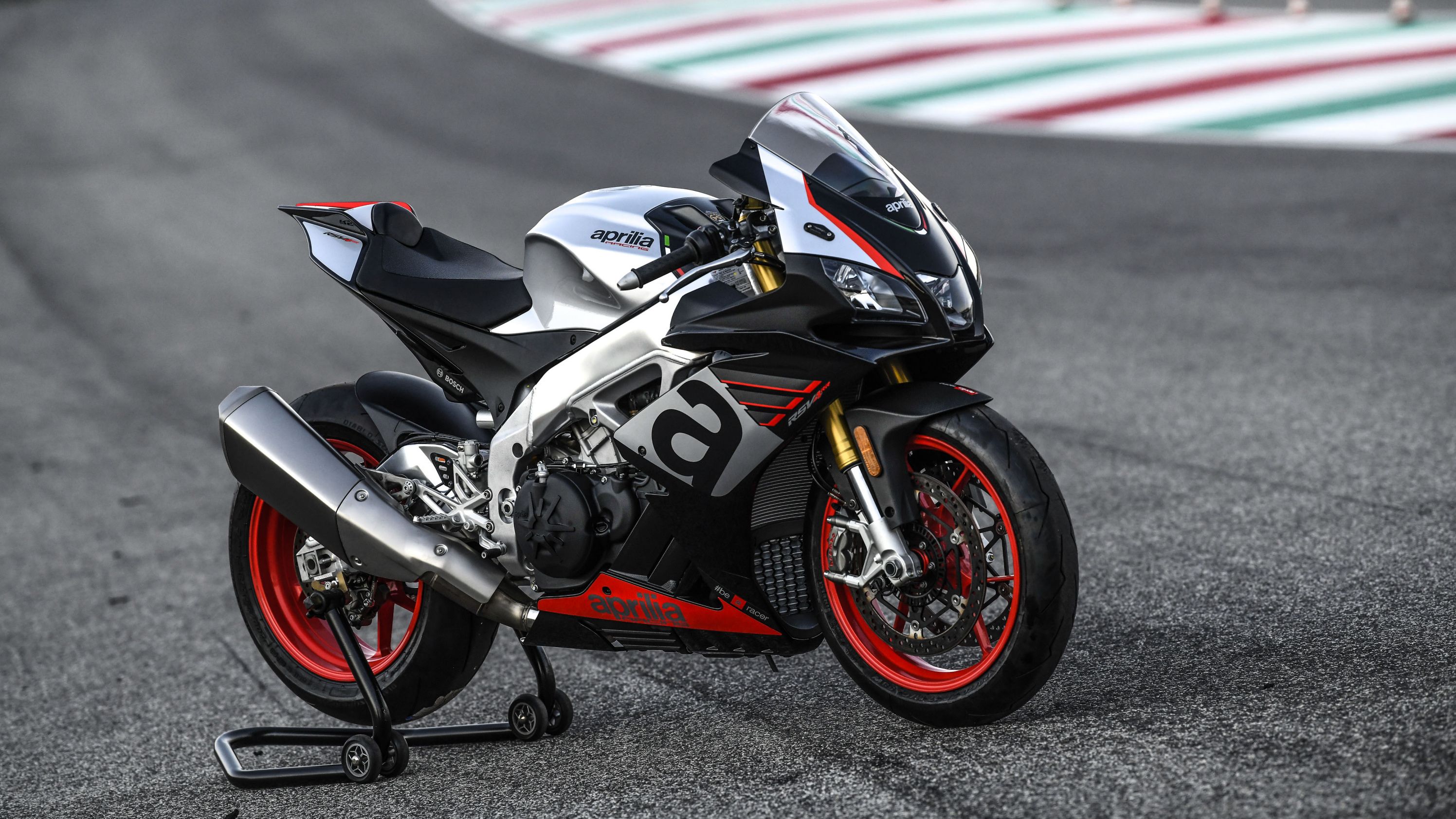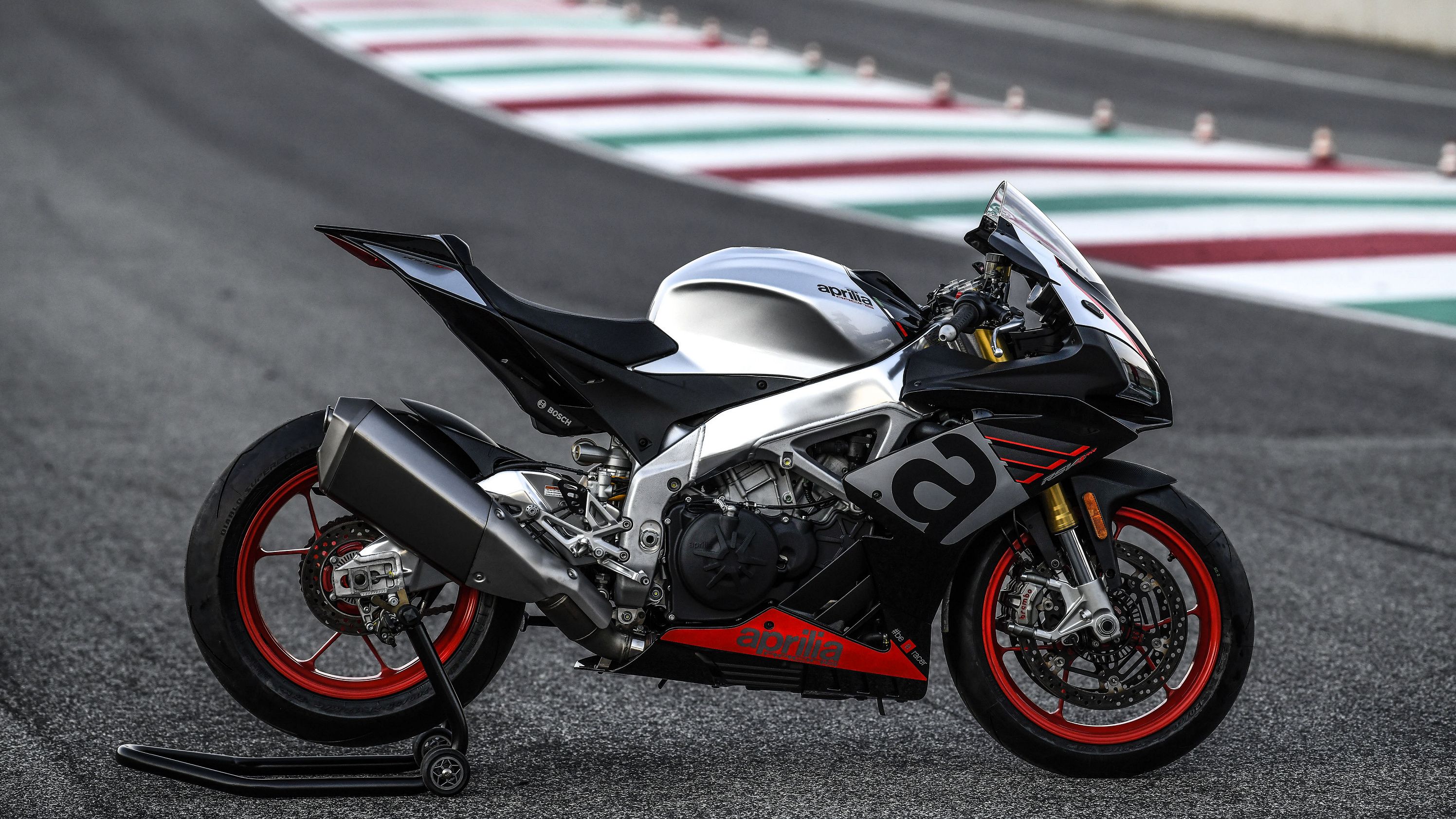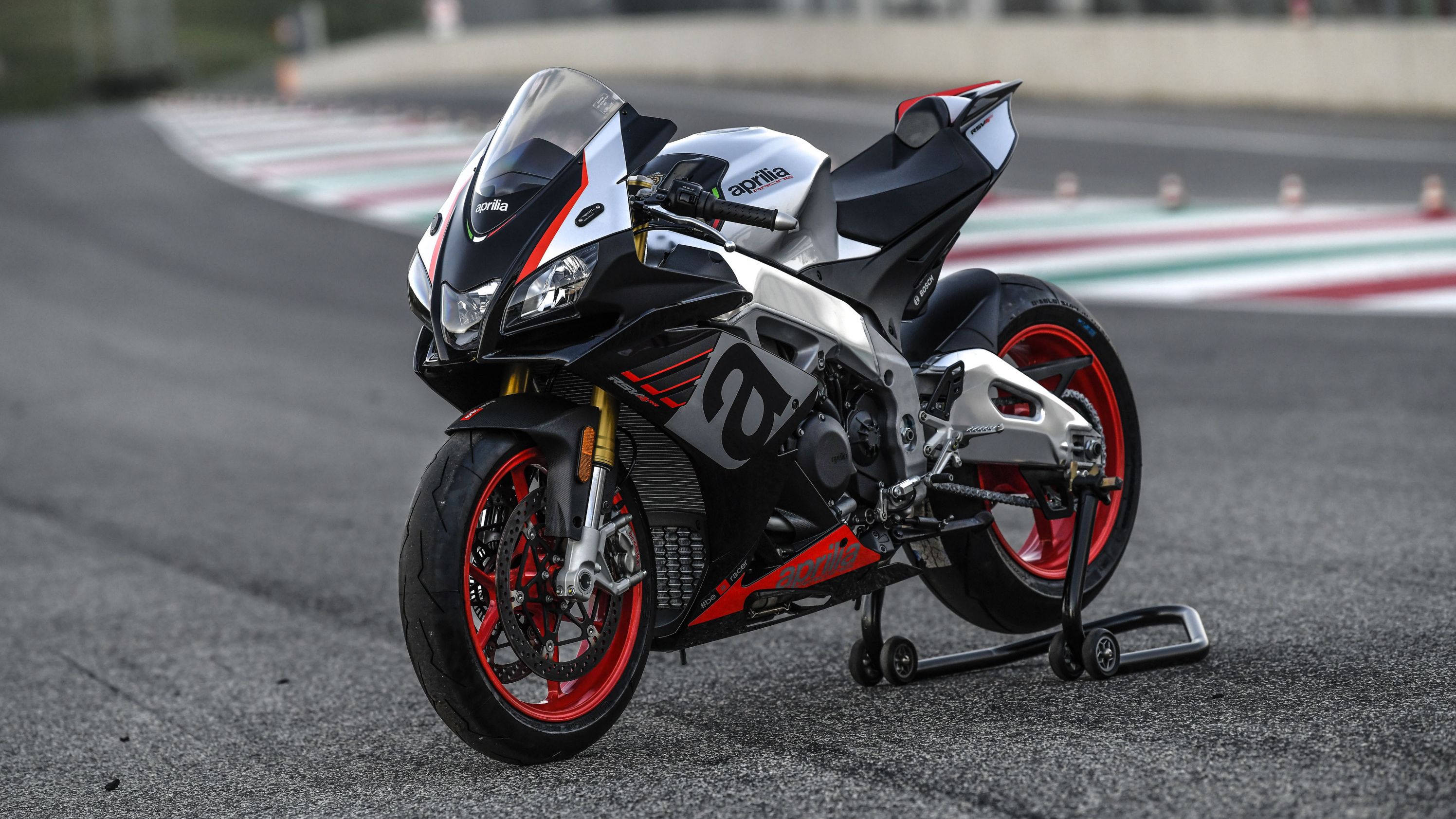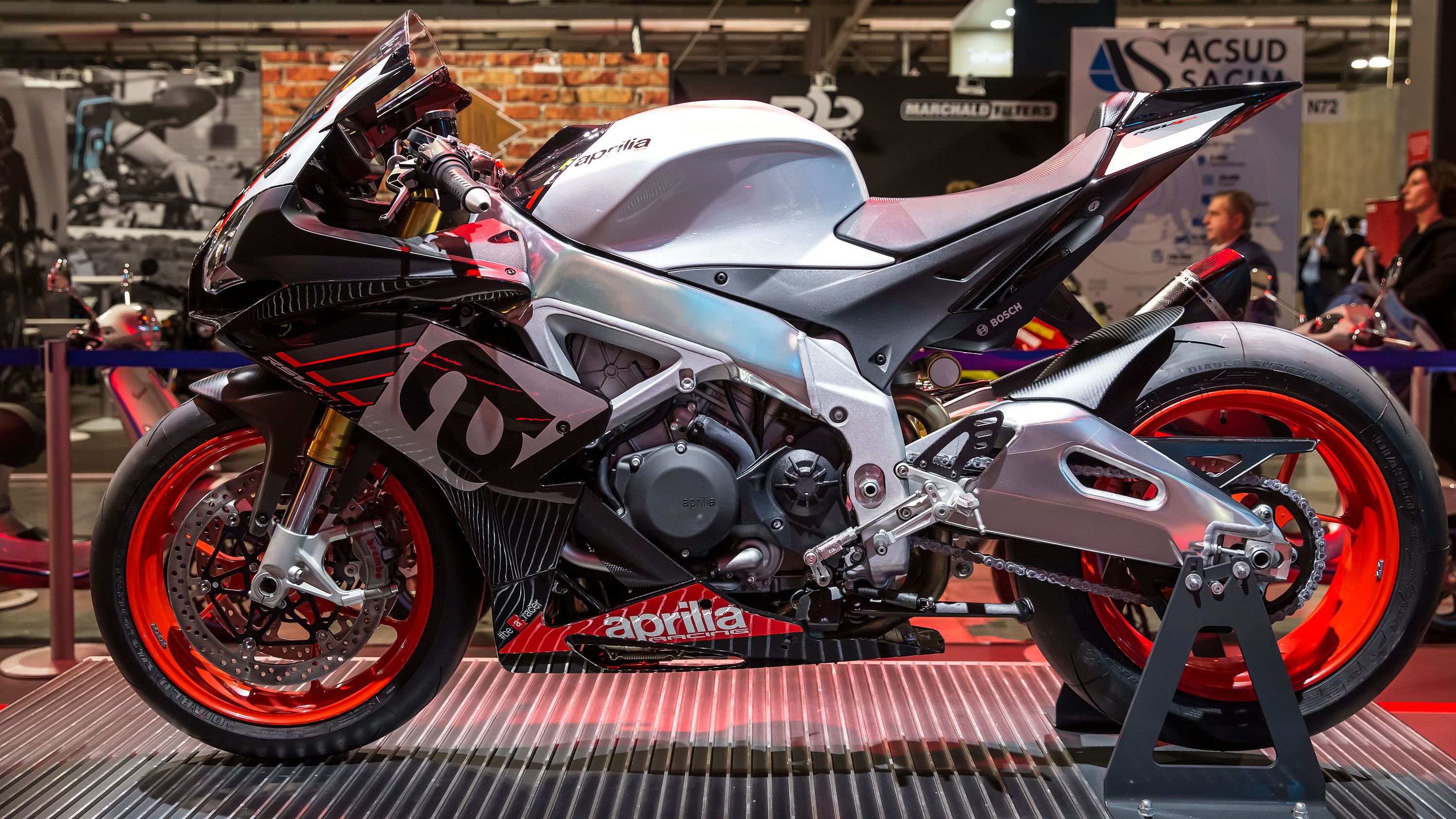The “RR” version of Aprilia's race-tastic 2019 RSV4 superbike is something of a dual-purpose ride. The "RR" is essentially a racebike made street-legal that can easily be set up for trackday through the use of the optional Track Kit. The liter-sized mill cranks out over 200 horsepower, and the “RR” comes with an electronics suite packed with top-shelf ride-quality gadgets to help you keep it rubber-side down.
2018 - 2019 Aprilia RSV4 RR
- Make: Array
- Model: 2018 - 2019 Aprilia RSV4 RR
- Engine/Motor: V4
- [do not use] Vehicle Model: Array
Aprilia RSV4 RR Design
The RSV4 RR hit the world stage back in 2016, and the line is still going strong with a revision in MY2018 that carries over largely unchanged into MY2019. Aprilia strikes a balance between track and street with its “RR” model, even if the racers kinda have their thumbs on the scale.
It starts out with a lightweight carbon-fiber front fender that helps keep unsprung weight low at the front axle and also protects the swept area of the inverted front fork tubes. A trio of headlight projectors – new in this revision -- dominate the front fairing above a pair of ram-air ports that take advantage of the pressurized air at the entry to give the volumetric efficiency a bit of a boost.
The redesigned windtunnel-tested fairing features a bubble screen up top to punch a hole in the wind for the rider's torso and head, and even the mirrors, also new in this revision, are designed for low-resistance penetration to maximize performance on the street. In order to make it easier to set up for track days, the LED front turn signals are integrated with the mirrors, and the Track kit comes with plugs to close off the mount holes in the front fairing.
Molded into the front fairing are a pair of stealth spoilers that work to increase the downforce on the front wheel in a bid to keep that front contact patch firmly planted on the tarmac. A narrow set of cheek fairings form the typical cowl-scoop that doubles as a shroud for the radiator and meets at the bottom to make a belly pan. There are a number of vents to help draw cooling air through the radiator/engine area, but unlike the typical fully-clad superbikes out there, the RR's panels leave much of the drivetrain exposed to save on weight.
A color digital display handles all the pertinent metrics with a score of indicator lights to finish off the instrumentation. Dead-short clip-on handlebars pull the rider forward over the 4.88-gallon fuel tank and place the center of the steering effort right in line with the steering stem for direct control and accurate feedback along with the leverage you'll need to lay into the sweeps.
The tank itself comes with the broad top and deep knee pockets necessary to pull the pilot's legs in out of the slipstream and provide the narrow waist you'll need for the most extreme body English, if you have the nerve for it. The upswept subframe forms a deep swale to cradle your butt, but if you'd like to share the experience with a friend, the “RR” comes with subframe-mount, fold-up footpegs that can quickly be struck for race days.
A low-profile LED taillight rides recessed under the tip of the tail with the blinkers and tag mounted on a short mudguard extension that, like the passenger footpegs, can be removed as a unit if you're trying to get down to your race weight. Even with the street-legal gear installed, there can be little doubt as to the serious nature of this machine.
Aprilia RSV4 RR Chassis
The dual-beam frame on the RSV4 RR is straight out of the WSBK division with a level of adjustability we usually don't find in the streetbike sector. Not even close. It provides an adjustable steering head that lets you dial in the rake with a variable rear-end height and swingarm pivot point, plus you can adjust the position of the engine within the frame. If you're really into the science of racing, this is the machine for you.
The structure is made up of both cast- and pressed-aluminum members for the lightweight strength they impart, and the gull-wing, yoke-style swingarm is of a similar construction and is 14 mm longer than the previous gen. Sachs is well represented on the “RR”. It starts with a steering damper that stabilizes the kickback generated when the front end gets light and comes back down out of alignment with the direction of travel. Given the power the “RR” brings to the table, this is more of a necessity than a luxury, to be sure.
A pair of inverted 43 mm stems float the front end with the full spectrum of adjustments and 4.72 inches of travel. Out back, a monoshock and APS progressive linkage deliver the usual three adjustments and 5.11 inches of travel along with a variable center-to-center length for a little bit of lagniappe.
As with just about every bike that boasts a lot of go, the “RR” brings a truckload of stop to the table with dual 320 mm discs up front and Brembo's four-pot opposed-piston M430 Monobloc anchors to bite them. A twin-piston anchor grabs the 220 mm rear disc, and both ends benefit from the Bosch 9MP ABS feature that bears a trio of profiles to let you dial in the desired level of intervention with Rear Wheel Lift-Up prevention built in. If you're one of those crazy riders who get off on pulling endos, you can disengage the RLM altogether.
Symmetrical, 17-inch rims run with a 120/70 up front opposite a 200/55, and naturally, the rubber comes with a ZR rating that can handle everything you can throw at them.
|
Frame: |
Aluminum dual beam chassis with pressed and cast sheet elements. Adjustments foreseen: headstock position and rake, engine height, swingarm pin height. Non adjustable Sachs steering damper |
|
Front Suspension: |
Sachs Fork with 43 mm Ø stanchions. Low profile forged aluminum radial caliper mountings. Adjustable spring preload and hydraulic compression and rebound damping. Wheel travel: 4.7 inches (120 mm) |
|
Rear Suspension: |
Double braced aluminum swingarm; mixed low thickness and sheet casting technology. Sachs monoshock adjustable in: hydraulics in rebound damping and compression, spring preload, center-to-center length. APS progressive linkage. Wheel travel: 5.1 inches (130 mm) |
|
Brakes, Front: |
Dual 320-mm diameter floating stainless steel disc with lightweight stainless steel rotor and aluminum flange with 6 pins. Brembo M430 monobloc radial calipers with 4 Ø 30 mm opposing pistons. Sintered pads. Radial pump and metal braided brake hose |
|
Brakes, Rear: |
Rear: 220 mm diameter disc; Brembo caliper with two Ø 32 mm separate pistons. Sintered pads. Pump with integrated tank and metal braided hose. ABS Bosch 9MP, adjustable to 3 maps, equipped with RLM (Rear wheel Lift-up Mitigation) strategy, which can be disengaged. |
|
Wheels, Front/Rear: |
Aprilia aluminum alloy rims with 3 split spokes, 3.5”X17”/6”X17” |
|
Tire, Front: |
Radial tubeless. 120/70 ZR 17 |
|
Tire, Rear: |
Radial tubeless. 200/55 ZR 17 (alternative: 190/50 ZR 17; 190/55 ZR 17) |
Aprilia RSV4 RR Drivetrain
As its ingeniously clever name implies, power comes from a V-4 powerplant to make the “RR” a real threat on both track and street. What kind of power are we talking about? Well, at 10,500 rpm the torque maxes out with 84.8 pounds o' grunt, and if you wind it on up to 13,000 rpm, you can count on 201 ponies – 16 horsepower more than the previous gen -- both measured at the shaft for an approximate top speed of 180 mph.
There's a 65-degree offset to the V to keep it compact, with four-valve heads and DOHC actuation up top. A 78 mm bore and 52.3 mm stroke adds up to give it a 999.6 cc total displacement and a smokin' hot 13.6-to-1 compression ratio that demands only the finest pump champagne to prevent preignition/detonation.
Dual oil pumps deliver pressurized lubrication with an oil radiator that joins the water radiator to draw heat away from the critical areas and vent it to atmosphere. The intake is rather special with ram-air intakes up front and variable-length funnels that increase overall power and deepen the torque well.
Throttle control falls to a RbW hand control and the engine control unit with a number of top-shelf systems that modify the signal and allow you to tune in the power deliver just where you want it with a trio of engine maps on tap. Said systems come bundled under the Aprilia Performance Ride Control umbrella (ella, ella) that sports a launch control feature to help you nail your holeshots, along with traction- and wheelie-control for extra stability once you get under way.
Power flows through a slipper-type clutch into the six-speed, cassette-type transmixxer bolstered by a quick-shift feature, and of course, you can reverse the shift lever for GP-style shifting if you prefer to shift manually.
|
Engine: |
Aprilia longitudinal 65° V-4 cylinder, 4-stroke, liquid cooling system, double overhead camshafts (DOHC), four valves per cylinder |
|
Bore x Stroke: |
78 mm x 52.3 mm |
|
Displacement: |
999.6 cc |
|
Compression Ratio: |
13.6:1 |
|
Max. Power At Crankshaft: |
201 hp (148 kW) @ 13,000 rpm |
|
Max. Torque At Crankshaft: |
84.8 lb-ft (115 Nm) @ 10,500 rpm |
|
Fuel System: |
Airbox with front dynamic air intakes. Variable length intake ducts controlled via the engine control unit. 4 Marelli 48-mm throttle bodies with 8 injectors and latest generation Ride-By-Wire engine management. Multiple engine maps selectable by the rider with bike in motion: T (Track), S (Sport), R (Race) |
|
Ignition: |
Magneti Marelli digital electronic ignition system integrated in engine control system, with one spark plug per cylinder and “stick-coil” type coils |
|
Starter: |
Electric |
|
Exhaust: |
4 into 2 into 1 layout, two oxygen sensors, lateral single silencer with ECU-controlled bypass valve and integrated trivalent catalytic converter (Euro 3) |
|
Alternator: |
Flywheel mounted 450W alternator with rare earth magnets |
|
Lubrication: |
Wet sump lubrication system with oil radiator and two oil pumps (lubrication and cooling) |
|
Transmission: |
6-speed cassette type gearbox. 1st: 39/15 (2.600); 2nd: 33/16 (2.063); 3rd: 34/20 (1.700); 4th: 31/21 (1.476) 5th: 31/23 (1.348); 6th: 34/27 (1.259). Gear lever with Aprilia Quick Shift electronic system (AQS) |
|
Clutch: |
Multi plate wet clutch with mechanical slipper system |
|
Primary Drive: |
Straight cut gears and integrated flexible coupling, drive ratio: 73/44 (1,659) |
|
Secondary Drive: |
Chain: Drive ratio: 41/16 (2.562) |
|
Traction Management: |
APRC System (Aprilia Performance Ride Control), which includes Traction Control (ATC), Wheelie Control (AWC), Launch Control (ALC), all of which can be configured and deactivated independently. |
Aprilia RSV4 RR Pricing
Last year's sticker on the RSV4 RR was $17,499, and since it carried over design-wise, that price is still good for MY19. Other than the red trim, the overall look is rather monochromatic with a choice between gray and black. Envy comes bundled with the standard equipment package.
|
Color: |
Grigio Rivazza, Nero Arrabbiata |
|
Price: |
$17,499 |
Aprilia RSV4 RR Competitors
It's tough to find suitable competition for the RSV4 RR without going straight to the top shelf, so I grabbed Kawasaki's Ninja H2 R for my head to head. The Kawasaki is definitely cut from the same cloth, perhaps even moreso since the “R” version of the Ninja H2 is actually a track-only bike that shuns the weight and drag associated with niceties such as mirrors, blinkers and headlights.
Kawi takes the downforce-inducing winglet tech to the extreme with no less than four spoilers to keep the front wheel planted and the contact patch all spread out even though the overall body paneling is even more sparse than the Aprilia's. Öhlins and Kayaba products float the H2 R with the usual full range of adjustments, and like the Aprilia, Brembo brakes haul it down with Kawi's proprietary ABS feature on overwatch.
Kawi packs a serious punch in the form of its supercharged liter engine that turns in a total of 121.5 pounds of torque and 300 ponies against 84.8/201, and that definitely gives Kawi a decisive edge. You'll pay for that extra power though, to the tune of $55,000 smackeroos, more than triple that of the RSV4 RR.
He Said
“No doubt, this is no bike for the timid, and I have no problem admitting that it's far too much for my meager skillset to comfortably handle. It kinda' makes me a little nervous 'cause unlike the H2 R, the price tag is well within reason and doesn't serve as any sort of firewall to keep the lesser-experienced riders away. In short; you'd better respect this machine, and unless you have access to a closed-ciruit track, you can disabuse yourself of the notion that you'll ever do it justice on public roads.”
She Said
My wife and fellow motorcycle writer, Allyn Hinton, says, “You know that Aprilia knows what it's doing when it comes to the RSV4. The engine is so smooth and there just seems to be torque no matter where you are in the rev range. Aprilia's motto for the RSV4 RR is, “Designed For Racers, Built For Riders” and you feel that in the bike and in the engine. A lot of superbikes are set up for track-oriented riding at the expense of comfort, and I'm not saying this bike is comfortable, but it's more comfortable than a lot of other bikes in this bracket. It's an elegant bike; a bike you'll buy when you don't need to prove anything to anyone else, because the bike has nothing to prove. It just is.”
Aprilia RSV4 RR Specifications
|
Engine & Drivetrain: |
|
|
Engine: |
Aprilia longitudinal 65° V-4 cylinder, 4-stroke, liquid cooling system, double overhead camshafts (DOHC), four valves per cylinder |
|
Bore x Stroke: |
78 mm x 52.3 mm |
|
Displacement: |
999.6 cc |
|
Compression Ratio: |
13.6:1 |
|
Max. Power At Crankshaft: |
201 hp (148 kW) @ 13,000 rpm |
|
Max. Torque At Crankshaft: |
84.8 lb-ft (115 Nm) @ 10,500 rpm |
|
Fuel System: |
Airbox with front dynamic air intakes. Variable length intake ducts controlled via the engine control unit. 4 Marelli 48-mm throttle bodies with 8 injectors and latest generation Ride-By-Wire engine management. Multiple engine maps selectable by the rider with bike in motion: T (Track), S (Sport), R (Race) |
|
Ignition: |
Magneti Marelli digital electronic ignition system integrated in engine control system, with one spark plug per cylinder and “stick-coil” type coils |
|
Starter: |
Electric |
|
Exhaust: |
4 into 2 into 1 layout, two oxygen sensors, lateral single silencer with ECU-controlled bypass valve and integrated trivalent catalytic converter (Euro 3) |
|
Alternator: |
Flywheel mounted 450W alternator with rare earth magnets |
|
Lubrication: |
Wet sump lubrication system with oil radiator and two oil pumps (lubrication and cooling) |
|
Transmission: |
6-speed cassette type gearbox. 1st: 39/15 (2.600); 2nd: 33/16 (2.063); 3rd: 34/20 (1.700); 4th: 31/21 (1.476) 5th: 31/23 (1.348); 6th: 34/27 (1.259). Gear lever with Aprilia Quick Shift electronic system (AQS) |
|
Clutch: |
Multi plate wet clutch with mechanical slipper system |
|
Primary Drive: |
Straight cut gears and integrated flexible coupling, drive ratio: 73/44 (1,659) |
|
Secondary Drive: |
Chain: Drive ratio: 41/16 (2.562) |
|
Traction Management: |
APRC System (Aprilia Performance Ride Control), which includes Traction Control (ATC), Wheelie Control (AWC), Launch Control (ALC), all of which can be configured and deactivated independently. |
|
Chassis: |
|
|
Frame: |
Aluminum dual beam chassis with pressed and cast sheet elements. Adjustments foreseen: headstock position and rake, engine height, swingarm pin height. Non adjustable Sachs steering damper |
|
Front Suspension: |
Sachs Fork with 43 mm Ø stanchions. Low profile forged aluminum radial caliper mountings. Adjustable spring preload and hydraulic compression and rebound damping. Wheel travel: 4.7 inches (120 mm) |
|
Rear Suspension: |
Double braced aluminum swingarm; mixed low thickness and sheet casting technology. Sachs monoshock adjustable in: hydraulics in rebound damping and compression, spring preload, center-to-center length. APS progressive linkage. Wheel travel: 5.1 inches (130 mm) |
|
Brakes, Front: |
Dual 320-mm diameter floating stainless steel disc with lightweight stainless steel rotor and aluminum flange with 6 pins. Brembo M430 monobloc radial calipers with 4 Ø 30 mm opposing pistons. Sintered pads. Radial pump and metal braided brake hose |
|
Brakes, Rear: |
Rear: 220 mm diameter disc; Brembo caliper with two Ø 32 mm separate pistons. Sintered pads. Pump with integrated tank and metal braided hose. ABS Bosch 9MP, adjustable to 3 maps, equipped with RLM (Rear wheel Lift-up Mitigation) strategy, which can be disengaged. |
|
Wheels, Front/Rear: |
Aprilia aluminum alloy rims with 3 split spokes, 3.5”X17”/6”X17” |
|
Tire, Front: |
Radial tubeless. 120/70 ZR 17 |
|
Tire, Rear: |
Radial tubeless. 200/55 ZR 17 (alternative: 190/50 ZR 17; 190/55 ZR 17) |
|
Dimensions & Capacities: |
|
|
Dry Weight: |
396.8 pounds (180 kg) |
|
Tank: |
4.9 gallons, 1-gallon reserve included (18.5 liters, 4-liter reserve included) |
|
Details: |
|
|
Color: |
Grigio Rivazza, Nero Arrabbiata |
|
Price: |
$17,499 |
Further Reading
Kawasaki Ninja H2 R
See our review of the Kawasaki Ninja H2 R.
Aprilia
Read more Aprilia news.













